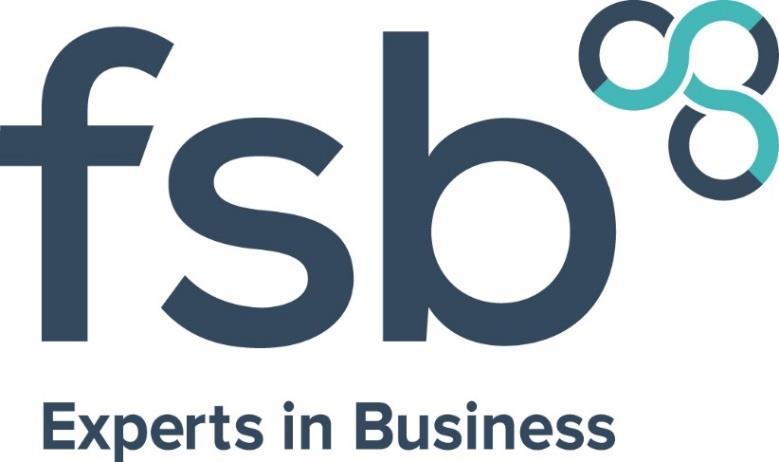
From Crisis to Recovery: An FSB Highlands & Islands
Tourism & Hospitality Survey Report
July 2021
1
Executive Summary
Small businesses sit at the heart of the visitor economy in Scotland and are critical to growth, job creation, and the industry’s recovery from the Covid-19 crisis.1 In this report, based on survey work with small businesses in the sector, the Federation of Small Businesses in Scotland (FSB) presents a snapshot of the current health of tourism and hospitality businesses across the Highlands and Islands Enterprise (HIE) area
The report finds that:
1. Economic recovery in the sector is highly uneven, with some businesses doing well (34%), some doing ok (24%), and a large group of businesses struggling to generate sales and profits (42%).
2. Resilience levels in the business community are also uneven, for while the majority of respondents were optimistic about surviving until 2022 (75%), a sizeable minority were pessimistic about their chances of survival (25%).
3. Reopening the industry did not lead to an instant “staycation boom” for all tourism businesses as some had forecast, and almost one in 10 businesses described themselves as barely staying afloat (9%).
4. Keeping up to date with changing government rules and regulations (46%), low turnover levels (41%) and travel restrictions (40%), were the top three concerns for business owners.
5. Recruitment challenges were a key concern for employers, with almost half (45%) highlighting that they did not have enough staff to meet their businesses’ needs. These challenges have led some firms to reduce opening hours and/or reduce the range of services offered.
6. While 40% of employers are responding to recruitment challenges by increasing pay to attract and retain staff, there are wider issues that will continue to impair progress in local labour markets – particularly for businesses in remoter parts of Scotland. The absence of an available local workforce, the supply of affordable and attractive staff accommodation, and the lack of access to migrant workers are all adversely affecting the ability of employers to recruit and retain staff.
The report proposes six recommendations for the Scottish and UK Governments to help the industry transition from crisis to recovery – including reducing Covid-19 restrictions on the sector when the adult population is fully vaccinated and piloting a remote visa for employers in the HIE area.
2
1 See: https://scottishtourismalliance.co.uk/tourism-recovery/
Introduction
The importance of tourism to the Highlands & Islands economy has long been recognised.
To quote directly from Highlands & Islands Enterprise (HIE’s) website:2
“With an average pre-COVID visitor spend of £1.5bn in the region [HIE Area], 3,200 registered tourism businesses locally, and with tourism jobs representing up to 43% of the workforce in some areas, tourism is central to Highlands and Islands life. It sustains many of our local, regional and island economies and communities.”
However, tourism & hospitality’s true significance to the region has perhaps only been fully recognised during the current pandemic, and research commissioned by HIE highlights that the industry has been one of the worst-hit by COVID-19. Indeed, the research found that visitor spend in the region is likely to have declined by up to £584m in the financial year 2020-21.3
Moreover, a survey conducted by FSB Scotland in January found that 54% of Highland businesses were closed at that time, 45% being required to do so by law. This compared with 35% nationally and only 27% for Edinburgh and Glasgow combined.
A month after the reopening of the industry,4 FSB surveyed tourism and hospitality businesses in the Highlands & Islands to examine the extent to which the visitor economy was bouncing back – as well as understanding more about the current barriers to business survival and growth. Specifically, we sought to determine:
• Current trading conditions for tourism & hospitality operators.
• Current barriers to business growth – with a particular focus on staffing and the impact of staff shortages on operations.
Recognising the differences between the Highlands & Islands and the rest of Scotland, the survey targeted businesses in the HIE Area – Shetland, Orkney, the Western Isles, Highland, Moray, Argyll and Arran. This region covers 51% of the Scottish landmass and has a population of around 470,000 and a business base of around 24,000 registered businesses.5 While respondents were able to indicate which part of the Highlands & Islands they were in, we have grouped these areas together into the following broad categories to enable better sample sizes and analysis6:
• The West – from Durness to Campbeltown, including Skye, Argyll Isles and Arran.
• The East - Caithness to Badenoch & Strathspey via South & East Sutherland, Easter Ross and the Black Isle, and including Loch Ness and Moray.
• The Central Highlands – covering Inverness, Loch Ness & Nairn, Moray and Badenoch & Strathspey.
• The Northern Highlands – covering Caithness, Sutherland and Ross-shire (i.e. the North Coast 500 (NC500) area.)
• Shetland – we received a good response from Shetland and so include it for comparative purposes.
2 See: https://www.hie.co.uk/our-region/our-growth-sectors/tourism/
3 See: https://www.hie.co.uk/media/9646/the-impact-of-covid-19-on-the-highlands-and-islands.pdf
4 The survey was conducted between the 24th of May and the 4th of June 2021 and we are grateful for the assistance of DMOs and Business Gateway offices for helping us to promote it.
5 See: https://www.gov.scot/publications/businesses-in-scotland-2020/ (xlsx.doc, Table 5)
6 Responses from Orkney and the Western Isles are included in headline analysis but excluded from these specific groupings due to sample size.
3
Key results
The survey received a total of 290 responses with a good sectoral and geographic spread. In terms of sectors, 48% of responses were from accommodation providers, 10% from activity providers, and the rest were split equally between visitor attractions, restaurants/cafes, and tourism retail.
Geographically, responses were evenly spread across the region, as can be seen in Figure 1 below. The largest proportion of responses came from: SE Sutherland; Easter Ross and the Black Isle; Shetland; West Sutherland & Wester Ross; Moray; Inverness, Loch Ness & Nairn; and Argyll and Arran
Figure 1: Where is your main tourism/hospitality business based?
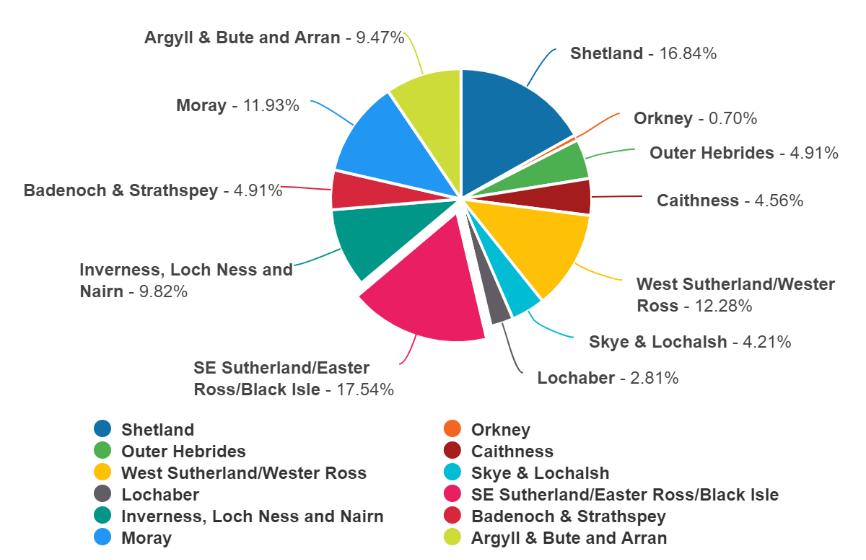
4
Business performance
The survey results suggest that unlocking has not led to a surge of people heading to the Highlands & Islands as many had anticipated. Talk of an economic recovery would therefore appear premature. Indeed, as figure two highlights, a third of all respondents (34%) described themselves as busy/very busy, and a quarter (24%) as doing ok However, this means that four in ten (42%) were struggling, and of these 9% described themselves as really struggling.

Moreover, there are noticeable differences across the region, with many of the more remote areas appearing to do better. Whether this is because consumers with pent up energy built up during lockdown are seeking remoter, wilder places to escape to, or because these areas are thought to be safer, or to a combination of factors, is unclear. However:
• Businesses in the West were typically doing appreciably better than those in the East, with 69% of the West describing themselves as doing ok or better, compared to only 57% in the East
• Best performing of all are those businesses in the Northern Highlands – those covered by the NC500 – where 76% of businesses were doing ok or better. Concerningly, businesses in the Central Highlands appeared to be doing less well amongst mainland businesses at 52%, while Shetland businesses were doing worst of all, with only 41% doing ok or better.
5
Figure 2: Overall, how is your main tourism/hospitality business doing?
Despite the season gradually extending in recent years, the Highlands & Islands still has a seasonal economy and most businesses have to make their money in the summer half of the year to carry them over the winter. Given all that has happened over the past sixteen months, many businesses will be concerned that a lack of custom now might prevent them from building up the required reserves.
6
Barriers to business growth
Given that 42% of tourism and hospitality businesses were struggling and that the sector remains tightly regulated by government’s Covid-19 restrictions, there is clearly no shortage of challenges facing business owners. The main concerns were summarised in figure 3 with keeping up to date with changing government rules and regulations being the most cited (46%).
Further, low turnover levels and travel restrictions were near the top of the list of concerns for business owners in the industry. And while recruitment issues remained a concern for around one in four businesses (23%), it is worth noting that this figure increased substantially to 40% when the responses to this question were examined solely for employers
Figure 3: What are you most worried about?

As one would expect, the degree of concern experienced by businesses is closely linked to how well they were performing. Businesses in Shetland were most anxious, followed by those in the Central Highlands, then the West, and finally, least worried of all, the Northern Highlands.
7
Staff shortages
Against a backdrop of press coverage about staff shortages in tourism and hospitality settings,7 FSB wanted to better understand the extent to which employers in the Highlands & Islands were experiencing recruitment challenges. Specifically, we wanted to know:
• Whether businesses have enough staff to run their operations.
• The impact staff shortages were having on businesses.
• Wider issues impacting on the recruitment efforts of businesses.
Overall, the survey results reveal a challenging picture for employers and their local labour markets in that 45% reported that they do not have enough staff to meet their needs (figure below)
Figure 4: Do you have enough staff to meet your business needs at the moment?
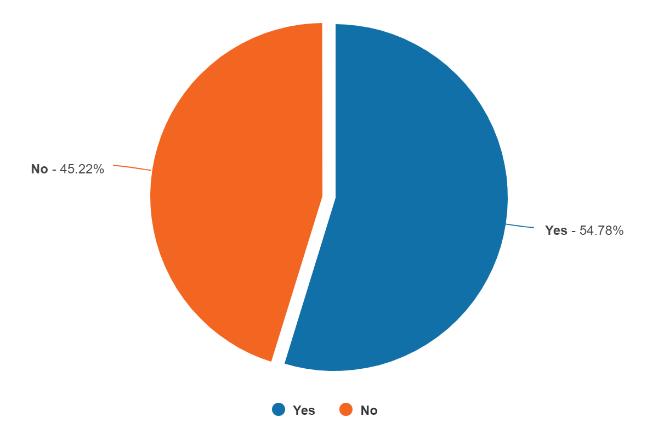
Unsurprisingly, there is variation across the region, with shortages being more critical in the small, remote, highly dispersed communities of the West (53%) than in the more densely populated East (33%). Similarly, it would appear from the small number of hotels that responded (25) that over six in ten (63%) were short-staffed.
Digging deeper into the impact staff shortages are having on business operations, figure 5 reveals that one in two employers (50%) were attempting to open their business as normal despite staff shortages. However, the other half were being forced to reduce the services they offered, their opening hours, or both (26% were reducing both). In some cases, as one business owner commented in the survey, this is causing businesses to remain closed:
7 See: https://www.heraldscotland.com/business_hq/19305145.staffing-crisis-looms-chefs-abandon-hospitality-sector/
8
“We are not yet open again due to not having a full complement of staff. We’re not prepared to over-work and stretch the staff or compromise on quality”.
This lack of staff is clearly having a big impact on employers and their staff with one business owner stating that:
“We have enough staff to open but they are having to work every shift. In such a demanding job it’s hard work every single day [and] it would be better to have more staff doing less shifts”.
Figure 5: The impact of staff shortages
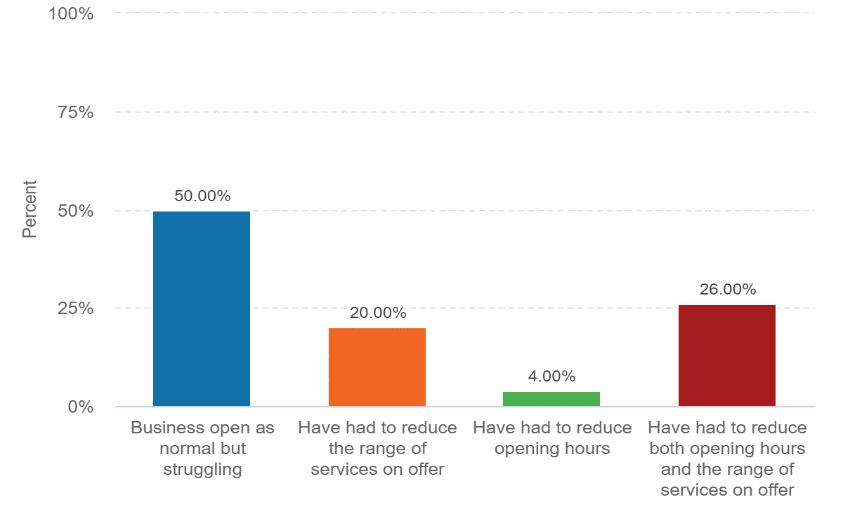
At a time when more households in Scotland and the rest of the UK will be ‘staycationing’, perhaps for the first time, it appears that businesses in the region are being held back by an acute lack of staff, meaning that the Highlands & Islands’ many world-class natural assets are not being matched by world-class customer service. These staff shortages may result in poorer customer service as well as reduced opening hours or provision of services.
Not only are businesses missing out on crucial income at a time when they should be building up the reserves needed to carry them through the long winter, undertake essential refurbishment, and start paying off any debts, but customer satisfaction may be adversely affected too, with knock on problems for return visits to the area.
To address these staffing issues businesses are taking a range of steps – summarised in the figure below. Common responses include actively recruiting locally (77%), nationally (36%) and internationally via the UK immigration system (10%) – as well as by increasing pay to attract and retain staff (40%).
9
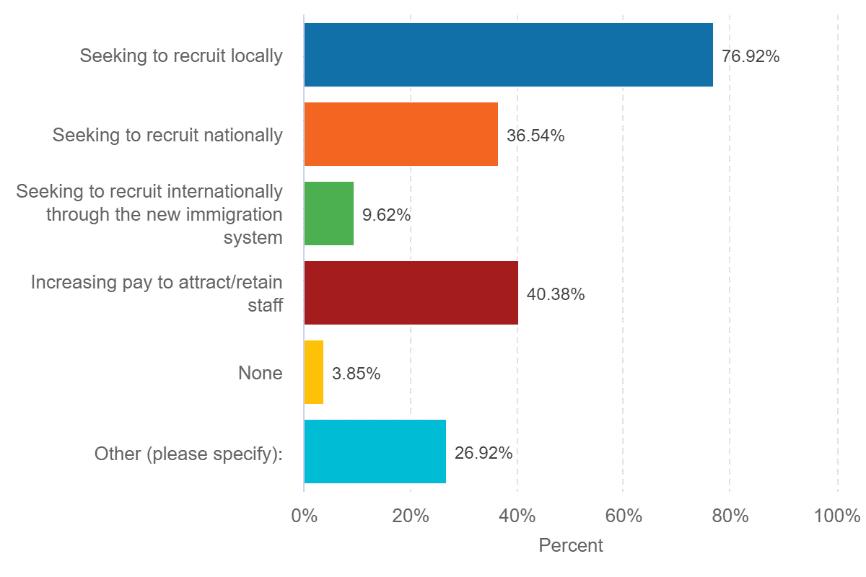
Given that the region is sparsely populated, with distinct local labour markets, there are regional variations which are worth highlighting – especially regarding pay. Indeed, it appears that employers in remoter areas are more likely to be increasing pay to retain and attract staff. For instance, 50% of employers in the Northern Highlands are increasing pay levels, while almost two thirds are doing so in the West (59%).
Whilst employers are currently doing all they can to rectify these shortages, there are many factors outwith their control which affect recruitment efforts. This survey found that a range of external factors continue to inhibit job creation in rural economies (see figure 7) including:
• Long-standing issues such as the absence of an available local workforce (70%) and the supply of affordable staff accommodation (31%) – with one business remarking that “[It is] impossible to find staff [and there is a] huge lack of housing to attract staff”.
• Covid-19 restrictions (31%) such as physical distancing which limit capacity and therefore revenue and profit levels.
• The absence of cost-effective access to migrant workers (25%) following the UK’s departure from the EU and the creation of a new immigration system.
10
Figure 6: The employer response to staff shortages
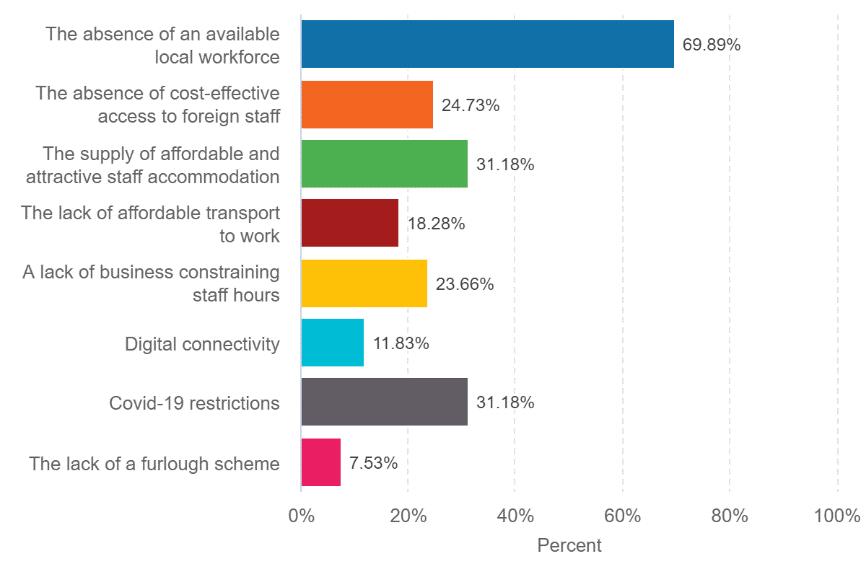
Unsurprisingly, there are variations across the region which are largely driven by the location of employers. For instance, employers are more likely to experience difficulties in finding local workers in the Northern Highlands (74%) and West (89%) – vast areas with small, dispersed populations. Likewise, the supply of affordable and attractive staff accommodation is a particular issue for employers in the Northern Highlands (44%)
It should be noted that these figures are for all types of tourism & hospitality businesses, and we know from discussions with businesses that some sectors are being affected more than others, not least restaurants and hotels.
11
Figure 7: External factors driving staff shortages
Recommendations
In the short term, with four in ten tourism & hospitality businesses in the HIE Area struggling at the moment, and a quarter pessimistic about surviving until 2022, it is imperative that smaller businesses in the industry are able to generate as much revenue and profit for the remainder of the tourism season as possible.
This requires action from the Scottish Government on five fronts:
1. Withdrawing Covid-19 regulations, such as physical distancing and self-isolation requirements, when most of the adult population is fully vaccinated
2. Enabling international travel by the end of the summer since the Highlands & Islands tourism industry cannot survive for long on domestic markets alone.
3. Significantly improving the communication of government rules and regulations to alleviate what is the main concern for the business community.
4. Providing ongoing financial support to struggling tourism and hospitality businesses in the area – as, where and when required – and especially if restrictions continue.
5. Better connecting job creation schemes like the Young Person’s Guarantee, which aims to provide employment opportunities to unemployed young people, to the acute staffing shortages experienced by businesses in the area. Highland Council’s Highland Employment Recruitment Offer (HERO fund) is a good example of what can be achieved.
Action is also required from the UK Government because the post-Brexit immigration system has made it prohibitively expensive and overly complex for smaller businesses to access migrant workers – a particular issue for a region that was historically reliant on these workers.
Therefore, as FSB has recommended on several occasions,8 the UK Government should adopt the Migration Advisory Committee’s 2020 recommendation and pilot a remote visa for the HIE area.
For further information please contact David Richardson on 07917 628 983, or email David.Richardson@fsb.org.uk
8 See: https://www.fsb.org.uk/resources-page/a-menu-for-recovery fsb-report-pdf.html and https://www.fsb.org.uk/resource-report/a-world-oftalent.html
12








